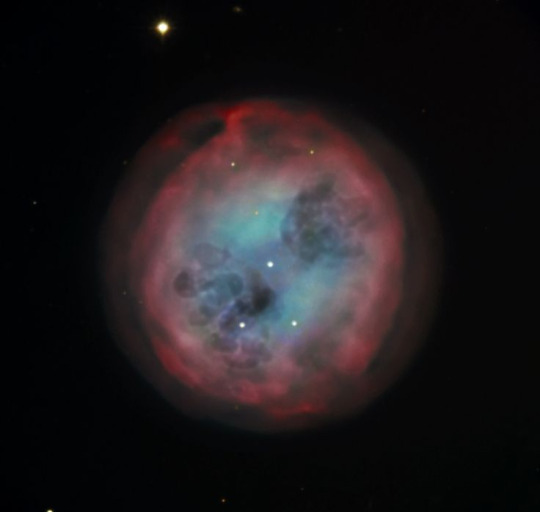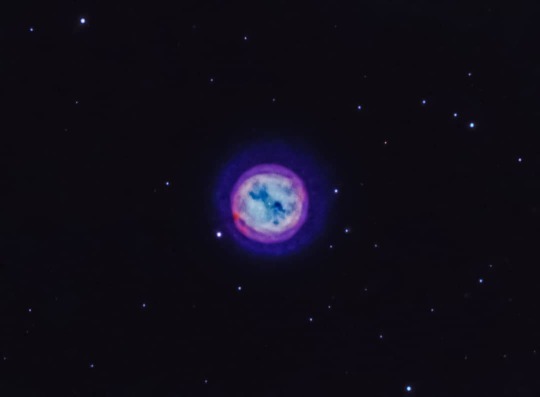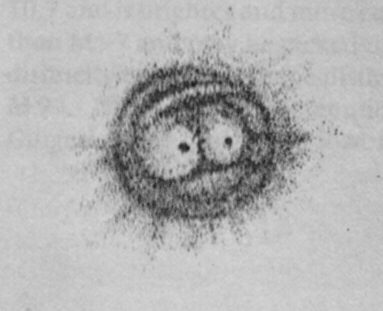#ngc 3587
Text

The Surfboard Galaxy (M108, upper right) and the Owl Nebula (M97, lower left) // David Cheng
Located near the Owl Nebula (M97) on the sky, the Surfboard Galaxy was discovered by Méchain in 1781, only three nights after he found M97. Messier himself observed it about a month later, although he didn't measure its position and so did not include it in his catalog.
William Herschel (1738-1822) independently discovered it in 1789. It wasn't until 1953 when American astronomer Owen Gingerich (1930-2023) identified it as M108.
#astronomy#astrophotography#messier marathon#galaxy#spiral galaxy#barred spiral galaxy#star-forming galaxy#nebula#emission nebula#planetary nebula#surfboard galaxy#owl nebula#messier#messier 108#M108#messier 97#M97#NGC 3587#NGC 3556#ursa major
243 notes
·
View notes
Text

The Owl Nebula (M97 or NGC 3587)
1 note
·
View note
Photo

M97 [NGC 3587] Owl Nebula In Ursa Major
#M97#NGC 3587#Owl Nebula#Ursa Major#nasa#stargazing#astrophoto#astrophotography#galaxy#astronomy#universe#space#nebula#spinningblueball#milky way#milky way galaxy#star
85 notes
·
View notes
Photo

The Comet, the Owl, and the Galaxy
Comet 41P/Tuttle-Giacobini-Kresak poses for a Messier moment in this telescopic snapshot from March 21, 2017. In fact it shares the 1 degree wide field-of-view with two well-known entries in the 18th century comet-hunting astronomer's famous catalog. Sweeping through northern springtime skies just below the Big Dipper, the faint greenish comet was about 75 light-seconds from our fair planet.
Dusty, edge-on spiral galaxy Messier 108 (bottom center) is more like 45 million light-years away. At upper right, the planetary nebula with an aging but intensely hot central star, the owlish Messier 97 is only about 12 thousand light-years distant though, still well within our own Milky Way galaxy.
Named for its discoverer and re-discoverers, this faint periodic comet was first sighted in 1858 and not again until 1907 and 1951. Matching orbit calculations indicated that the same comet had been observed at widely separated times. The comet 41P orbits the Sun with a period of about 5.4 years.
Credit: Barry Riu
#astronomy#space#cosmos#universe#astrophotography#cosmology#science#Comet 41P#Tuttle-Giacobini-Kresak#comet#Messier 108#M108#galaxy#spiral galaxy#Owl Nebula#Messier 97#M97#NGC 3587#nebula#planetary nebula
672 notes
·
View notes
Photo

The Owl Nebula (M97 or NGC 3587) is a planetary nebula located approximately 2,030 light years away in the constellation Ursa Major.
0 notes
Photo

M97 the owl nebula Hoot hoot! (Swipe to see a barn owl I found) The Owl Nebula (also known as Messier 97, M97 or NGC 3587) is a planetary nebula located approximately 2,030 light years away in the constellation Ursa Major. The nebula is approximately 8,000 years old. It is approximately circular in cross-section with a little visible internal structure. It was formed from the outflow of material from the stellar wind of the central star as it evolved along the asymptotic giant branch. The nebula is arranged in three concentric shells, with the outermost shell being about 20–30% larger than the inner shell. The owl-like appearance of the nebula is the result of an inner shell that is not circularly symmetric, but instead forms a barrel-like structure aligned at an angle of 45° to the line of sight. I'd also like to add that if you love owls and haven't seen it then you should buy the documentary "owl power" on prime video. Well worth it! My son and I have watched it well over 300 times. Equipment: Gso rc6 with astrophysics ccdtv 67 spaced for .72x focal reduction, qhy polemaster, zwo asi290mm mini, zwo asi1600mm cool, zwo efw8 using 1.25" filters, hydrogwn alpha filter at 5nm and oxygen 3 filter at 3nm, stellardrive heq5, modified zwo off axis guider. Data: Hydrogen alpha: 75x5min (6hr 15min) Oxygen III: 77x5min (6hr 25min) Total integration: 12hr 40min Software: Sequence generator pro, phd2, eqmod, polemaster, stellarium, pixinsight, and light room. Most of the above mentioned gear (except stellardrive heq5) can be found at optcorp via my affiliate link http://bit.ly/32ahgqc #OPTeam #optcorp #asiweek #space #cosmos #owls #barnowl #nebulae https://www.instagram.com/p/CAOw0V7n7il/?igshid=emvszzt3b5id
1 note
·
View note
Photo

Part of a wide field view of M108 (NGC 3556) and the Owl Nebula M97 (NGC 3587). Imaged with the @meadeinstruments 70mm Quad Astrograph on the LX850. The @primalucelab Eagle Computer is used for image management and system control. #nebula #galaxy #planetarynebula #owlnebula #m108 #m97 #astronomy #astrophotography @meadeaustralia #albuquerque #astrology #newmexico (at New Mexico) https://www.instagram.com/p/B76ye1ZJjEq/?igshid=1uu5bevny1tdf
#nebula#galaxy#planetarynebula#owlnebula#m108#m97#astronomy#astrophotography#albuquerque#astrology#newmexico
0 notes
Photo


Der Planetarische Nebel M 97, Eulennebel oder NGC 3587
Der Eulennebel im Sternbild „Großer Wagen" war visuell schon immer eine Herausforderung für mich. Selbst mit einem 40 cm Spiegel sind die Strukturen des Eulengesichts kaum zu sehen. Der Planetarische Nebel ist die Leiche eines explodierten Sterns mit einer scheinbaren Helligkeit von 9,9 mag befindet sich in der Milchstaße in einer Entfernung von etwa 2000 Lichtjahren von uns entfernt. Das Alter wird zwischen 6000 und 8000 Jahren angegeben.
Die Spiralgalaxie Messier 108 oder als NGC 3556 bezeichnet mit einer scheinbaren Helligkeit von 9,9 mag, ist für mich visuell ebenso eine Herausforderung.
APO 127/952 mm, EOS6D, 80 Aufnahmen je 60 Sek. ISO 6400
0 notes
Text
Messier 97 - The Owl Nebula
Messier 97 – The Owl Nebula
The Owl Nebula (also known as Messier 97, M97 or NGC 3587) is a planetary nebula located approximately 2,030 light years away in the constellation Ursa Major. The owl-like appearance is caused by various formed shells expanding away from the central star. Tech Specs: This image is composed of 23 x 60 second images at ISO 3,200 with 4 x 60 second darks and 4 x 1/4000 second bias frames using a…
View On WordPress
0 notes
Photo

M97 & M108 M97 and M108 are a pair of deep sky objects separated by approximately 50 arc minutes and located in the constellation Ursa Major. The close pairing is a cosmic coincidence since they are not physically associated with each other. M97 is a planetary nebula in our own galaxy while M108 is a spiral galaxy over ten thousand times more distant. M97 and M108 are best seen during the spring. The Messier Spring Star Chart shows the position of all Messier objects visible during that season. The image above shows the uncropped view of M97 (left) and M108 (right) through the ASA N12 Corrected Newtonian Astrograph (North is to the right). For another image of this pair using the Takahashi E-180 Astrograph, see M97 and M108 (TAK E-180) . M97 - Owl Nebula Messier 97 or M97 (also designated NGC 3587) is a planetary nebula in the constellation Ursa Major. It has an apparent visual magnitude of 9.9 and its angular diameter is 3.4x3.3 arc-minutes. M97 lies at an estimated distance of 2600 light years. The Equinox 2000 coordinates are RA= 11h 14.8m, Dec= +55° 01´. As one of the more famous objects in the Messier Catalog, it is commonly known as the Owl Nebula. M97 was discovered by P. Méchain in 1781. It is is one of only four planetary nebulae in the Messier Catalog (M27, M57, M76, and M97). The name "Owl Nebula" is attributed to the 3rd Earl of Rosse who applied it M97 in 1848. According to Stoyan et al. (2010), the distance of this planetary nebula is 4140 light years and its diameter is 3.5 light years. Its estimated age is 6,000-12,000 years. M97 lies just 50 arc minutes southwest of the spiral galaxy M108. For more information on M97, see the Messier Catalog as well as specific entries for M97 in Wikipedia and SEDS. M108 Messier 108 or M108 (also designated NGC 3556) is a spiral galaxy in the constellation Ursa Major. It has an apparent visual magnitude of 10 and its angular diameter is 8x1 arc-minutes. M108 lies at an estimated distance of 45 million light years. The Equinox 2000 coordinates are RA= 11h 11.5m, Dec= +55° 40´. This nearly edge-on spiral galaxy was discovered by P. Méchain in 1781. According to Stoyan et al. (2010), the distance of M108 is 46.0 million light years and its diameter is 100,000 light years. M108 lies just 50 arc minutes northeast of the planetary nebula M97. For more information on M108, see the Messier Catalog as well as specific entries for M108 in Wikipedia and SEDS. © ASTROPIXEL.COM
0 notes
Text

The Owl Nebula, M97 // Scotty Bishop
The name comes from its distinctive shape. When the original star collapsed, it expelled matter in two opposing directions. Those two jets are almost aligned with our line-of-sight, but are just slightly off. The dust in the jets blocks some of the light in the nebula, giving it the appearance of two dark eyes.
Although it was discovered by Méchain in 1781, it was William Parsons, 3rd Earl of Rosse (1800-1867) who drew this nebula in 1848 and noted it's owl-like appearance: "Two stars considerably apart in the central region, dark penumbra round each spiral arrangement, with stars as apparent centres of attraction. Stars sparkling in it; resolvable."

Here's his original drawing! It's a very cute owl! 🦉
#astronomy#astrophotography#messier marathon#nebula#emission nebula#planetary nebula#owl nebula#messier#messier 97#M97#NGC 3587#ursa major
153 notes
·
View notes
Photo

The Owl Nebula (M97, right) and the Surfboard Galaxy (M108, left) // David Payne
#astronomy#astrophotography#nebula#emission nebula#planetary nebula#owl nebula#messier#messier 97#M97#NGC 3587#surfboard galaxy#messier 108#M108#NGC 3556#ursa major
245 notes
·
View notes
Text

The Owl Nebula, M97 // Don Robertson
#astronomy#astrophotography#nebula#emission nebula#planetary nebula#owl nebula#messier#messier 97#M97#NGC 3587#ursa major
54 notes
·
View notes
Text

The Owl Nebula, M97 // Roger Nichol
The last planetary nebula in Messier's catalog, the Owl Nebula is about 2,000 light years away and about 8,000 years old. As in all planetary nebulae, it formed when a Sun-like star died and ejected its outer atmospheric layers in the process. Those layers are now heated and ionized by the white dwarf that remains. That white dwarf is 70% the mass of the Sun and is scorchingly hot at 123,000 degrees!
#astronomy#astrophotography#messier marathon#nebula#emission nebula#planetary nebula#owl nebula#messier#messier 97#M97#NGC 3587#ursa major
29 notes
·
View notes
Text

The Surfboard Galaxy (M108, upper left) and the Owl Nebula (M97, lower right) // Andrew Burwell
#astronomy#astrophotography#nebula#emission nebula#planetary nebula#owl nebula#galaxy#spiral galaxy#star-forming galaxy#barred spiral galaxy#surfboard galaxy#messier#messier 97#M97#messier 108#M108#NGC 3556#NGC 3587#ursa major
33 notes
·
View notes
